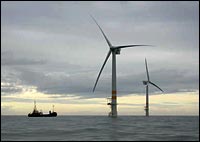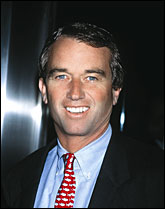A long-simmering disagreement within the environmental community over a plan to build a massive wind farm off the coast of Cape Cod, Mass., is now boiling over into a highly public quarrel.

The future of Nantucket Sound?
Photo: NREL.
The four-year-old battle started heating up last summer when Greenpeace USA staged a demonstration against well-known eco-activist Robert F. Kennedy Jr., who’s been an outspoken opponent of the proposal for a 130-turbine wind-power project in Horseshoe Shoal, a shallow portion of Nantucket Sound south of Cape Cod. Kennedy — a senior attorney at Natural Resources Defense Council and a pioneer in the waterway-protection movement — was on a sailboat for an event with the Alliance to Protect Nantucket Sound, which opposes the wind project. A Greenpeace vessel cruised up alongside with a banner that read, “Bobby, you’re on the wrong boat” — a stunt that was part of a larger Greenpeace campaign pressuring Kennedy to change his mind on the development. (Hear audio from the Greenpeace/Kennedy confrontation.)
In mid-December, Kennedy, wanting to explain his position to critics and the public at large, published an impassioned op-ed in The New York Times in which he argued that the wind farm would mar a precious seascape, privatize a publicly owned commons, and damage the local economy.
That, in turn, prompted about 150 environmental advocates — including global-warming authors and activists Bill McKibben and Ross Gelbspan, Bluewater Network founder Russell Long, and youth leader Billy Parish — to circulate a letter asking Kennedy to reconsider his position. “We are, simply put, in a state of ecological emergency,” it read. “Constructing windmills six miles from Cape Cod, where they will be visible as half-inch dots on the horizon, is the least that we can do.”
Signers of the letter also included “Death of Environmentalism” authors Michael Shellenberger and Ted Nordhaus, who made the quarrel far more personal — and nasty — in an op-ed in the San Francisco Chronicle last month. They called on Kennedy to step down from his position at NRDC, and took a swipe at his famous family by criticizing “the privileged patricians of a generation for whom building mansions by the sea was indistinguishable from advocating for the preservation of national parks or big game hunting in the wilds of Africa.”
Kennedy shot back this week with his own opinion piece in the San Francisco Chronicle, calling Shellenberger and Nordhaus’s attacks “dishonest vitriol.”
Choosing Sides
The venture at the center of all the fuss — the Cape Wind Project, being developed by Cape Wind Associates — would be the first major offshore wind installation in the U.S., and one of the largest wind farms in the world. It would produce enough electricity to meet nearly 75 percent of demand on Cape Cod and nearby islands Nantucket and Martha’s Vineyard, with peak output of 420 megawatts.
The permitting process for the project, which began in 2001, is nearing completion, and Cape Wind is widely expected to get the green light from the Department of Interior’s Minerals Management Service within a year. If state permits for the sea-bottom transmission lines are obtained, as expected, construction on the wind farm could begin mid-2007 and be completed in roughly two years.
The Humane Society of the United States, the International Fund for Animal Welfare, the Massachusetts Audubon Society, and a handful of local and state conservation groups have raised concerns about Cape Wind. On the other hand, a number of major national environmental groups have been supportive, including Greenpeace, the Union of Concerned Scientists, World Wildlife Fund, and NRDC. Some, though, are waiting to officially endorse the project until the final environmental impact statement comes out later this year and clears up uncertainties about avian impacts and other issues.
“Most of the data so far on possible environmental impacts has been very encouraging, but there are still questions we want answered,” said Nathanael Greene, NRDC’s renewable-energy expert. “Our position currently is cautious enthusiasm. It’s a historic proposal with incontrovertible benefits.” The group’s comments on Cape Wind’s environmental impact statement characterized the project as “the largest single source of supply-side reductions in CO2 currently proposed in the United States, and perhaps in the world.” NRDC reiterated its position on the wind farm in a statement released the day Kennedy’s New York Times op-ed was published.

Robert F. Kennedy Jr.
Cape Fear
In his op-ed, Kennedy contended that “[h]undreds of flashing lights to warn airplanes away from the turbines will steal the stars and nighttime views. The noise of the turbines will be audible onshore … [and] the project will damage the views from 16 historic sites and lighthouses on the cape and nearby islands.”
He framed the debate as a clash between industry and wilderness: “[S]ome places should be off limits to any sort of industrial development. I wouldn’t build a wind farm in Yosemite National Park. Nor would I build one on Nantucket Sound … All of us need periodically to experience wilderness to renew our spirits and reconnect ourselves to the common history of our nation, humanity, and to God.”
Kennedy agreed last Friday to meet with representatives from the group of letter writers to discuss their request, but indicated in an interview this week with Muckraker that he doesn’t intend to change his position — rather, he hopes to convince his critics to change theirs. “It’s dangerous for environmentalists to have the knee-jerk reaction that all wind power must be good,” he said.
Kennedy said in the interview that his primary concern is not the project’s impact on wild sea life and ocean views, but the economic impact it would have on the local fishing community. “It will evict more than 100 of Cape Cod’s treasured commercial fishermen who run sustainable operations from their traditional fishing grounds, and destroy their livelihood,” he said, explaining that their nets would get tangled in the electric cables on the seabed. According to Kennedy, the project could have an over $1 billion impact on the local fishing industry and the tourist economy, given the blighted views and obstacles it would pose to the thousands of recreational sailors who visit Nantucket Sound annually.
“I think it’s a big mistake for environmentalists to alienate our natural allies like commercial fishermen and boaters, who have long been strong supporters,” he said. He argued that the hard feelings and publicity surrounding Cape Wind could tarnish the reputation of wind energy nationally. “This is a very badly sited project that will end up hurting the battle against global warming, not advancing it,” he said.
If the turbines were built five miles farther beyond the coastline (they are now currently planned for about six miles offshore), where they wouldn’t interfere with fishing interests, Kennedy said he could back the project. He also said he supported offshore wind projects in other regions that would pose less of an economic and environmental threat, including two that have been proposed for offshore areas near Long Island and New Jersey.
“I never intended to be a champion on this issue,” he said, alluding to pressure from Greenpeace that forced him to defend his position. “There are plenty of places to put windmills, and plenty of projects I will support. But there’s only one Horseshoe Shoal. You can’t move your fishing ground somewhere else.”
Cape Wind Avengers
Cape Wind CEO Jim Gordon told Muckraker that environmental reviews of the project refute many of Kennedy’s claims about the potential environmental hazards and noise pollution. Cape Wind and its backers also argue that the development would pose minimal harm to the fishing community, noting that the cables carrying the electricity back to shore would be embedded six feet under the seabed.
Some proponents of the project argue that it could actually attract tourists who would want to see the nation’s most ambitious symbol of a clean-energy future. (It’s not as nutty as it sounds — offshore wind installations in Ireland and Denmark have proved a boon to tourism, not a setback.)
The developers say there is no viable location for the project other than the shallow waters of Nantucket Sound. “Any farther out would be cost-prohibitive,” said Gordon. “The challenge for this project is to demonstrate that wind power is not only environmentally safe, but commercially viable.”
Even if there were an alternative site, advocates say, redesigning and re-permitting would delay the project several more years.
“We simply don’t have that kind of time,” said McKibben, “given widespread predictions that the climate crisis could be irreversible in 10 years without substantial reductions in carbon output.”
Gelbspan argued that even if the turbines were to deprive 100 or more fishers of their jobs, “The calculus is not hard: that is a more-than-reasonable trade-off. This landmark project would offset approximately 880,000 tons of carbon dioxide a year, the equivalent of keeping over 150,000 vehicles off the road. What’s more, it would create between 600 and 1,000 new jobs, and be a crucial springboard for fast-tracking renewable-energy development in America.” He added that state officials, as well as the project developers, should be obligated to help any fishers who lose their livelihoods through buyouts, retraining, or assistance in finding new fishing grounds.
To John Passacantando, executive director of Greenpeace USA, the debate comes down to weighing local NIMBY concerns against global climate concerns. “I respect people who wage NIMBY battles — the environmental movement was founded on people protecting their local, sacred areas,” he said. “But today, solving the climate crisis has become so urgent that it trumps NIMBYism. It’s as simple as that.”
A Long and Windy Road
Several Cape Wind advocates praised Kennedy as one of the most charismatic and influential leaders in the environmental community. Yet they raised concerns that his leadership on this issue would be hobbled if he appeared unwilling to make certain sacrifices.
Said Gelbspan, “Kennedy’s decision to counterpose such extraordinarily unequal consequences — the wind farm’s negative impact on coastal views and local fishermen versus its critical role in forging climate-change solutions — bespeaks a lack of understanding of the consequences of escalating climate change.”
Kennedy vehemently rejected the notion that he doesn’t take the climate crisis seriously. “There is nobody in this country who is more concerned about global warming than me, nobody,” he told Muckraker.
Indeed, Kennedy has helped bring mainstream visibility to the climate issue through lectures, fund-raisers, and rallies. He even played a role in convincing FOX News to air a surprisingly scientific special on climate change in November, in which he appeared as a correspondent (much to the consternation of right-wing pundits).
Kennedy also said he was emphatically opposed to an amendment unveiled by Rep. Don Young (R-Alaska) last month that would prohibit all major offshore wind installations from being sited within one and a half miles of a commercial shipping route, even though it would block the Cape Wind project. Young attached the amendment to the Coast Guard budget bill, which is expected to be voted on in February.
Yet even if Young’s amendment doesn’t pass, other congressional efforts to thwart Cape Wind are likely to follow in this final year of the project’s permitting process.
The fight over Cape Wind is far from finished.



